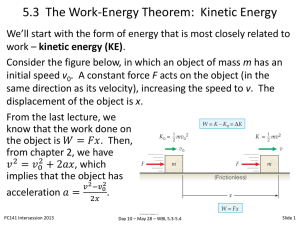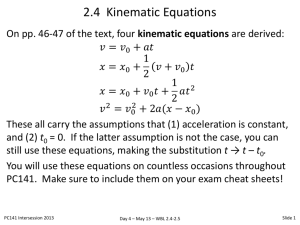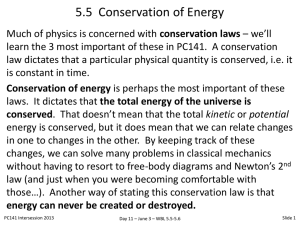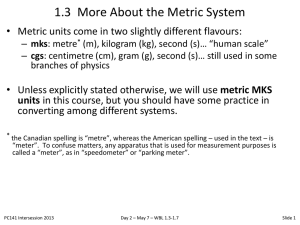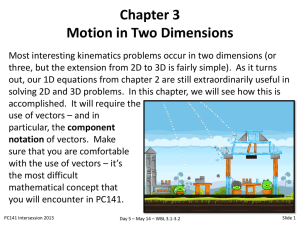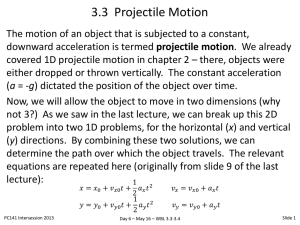141S13-NotesCh5a-May27
advertisement
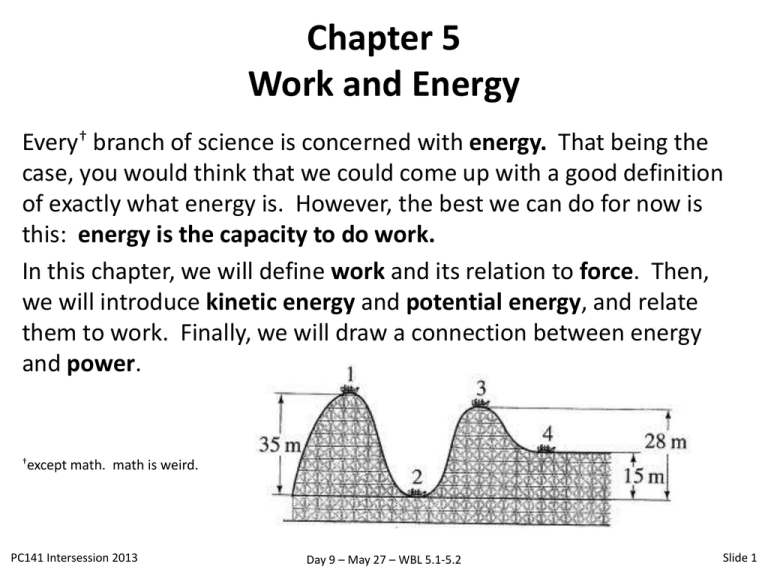
Chapter 5 Work and Energy Every† branch of science is concerned with energy. That being the case, you would think that we could come up with a good definition of exactly what energy is. However, the best we can do for now is this: energy is the capacity to do work. In this chapter, we will define work and its relation to force. Then, we will introduce kinetic energy and potential energy, and relate them to work. Finally, we will draw a connection between energy and power. †except math. math is weird. PC141 Intersession 2013 Day 9 – May 27 – WBL 5.1-5.2 Slide 1 5.1 Work Done by a Constant Force Work describes what is accomplished by a force when it moves an object through a particular displacement. Its mathematical definition is as follows: The work done by a constant force is equal to the product of the magnitudes of the displacement and the component of the force that is parallel to the displacement. That’s a rather confusing sentence. The situations depicted on the next two slides will clarify it. The symbol for work is W (it’s capitalized, so as to not confuse it with the magnitude of weight, w). PC141 Intersession 2013 Day 9 – May 27 – WBL 5.1-5.2 Slide 2 5.1 Work Done by a Constant Force In part (a), there is a force F acting on the crate, but it does not move. Since there is no displacement, no work is done. In part (b), there is a force F acting on the waterskier, and this force is in the same direction as his displacement d. In this case, 𝑾 = 𝑭𝒅. PC141 Intersession 2013 Day 9 – May 27 – WBL 5.1-5.2 Slide 3 5.1 Work Done by a Constant Force In part (c), there is a force F and a displacement d, but they are not in the same direction. Instead, the force acts at an angle 𝜃 to the displacement. From chapter 3, we know that the component of F along the direction of d is 𝐹∥ = 𝐹 cos 𝜃 (the subscript “∥” indicates the “parallel component”). Here, the work is 𝑾 = 𝑭∥ 𝒅 = 𝑭𝒅 𝐜𝐨𝐬 𝜽 Don’t be fooled into thinking that there are three different equations for work. The one above works in every case…for the waterskier, 𝜃 = 0, and (since cos 0 = 1), the equation reduces to 𝑊 = 𝐹𝑑. Do note however that this equation is only valid for constant forces. PC141 Intersession 2013 Day 9 – May 27 – WBL 5.1-5.2 Slide 4 5.1 Work Done by a Constant Force To complete the case in part (c), we note that the perpendicular component of force, 𝑭⫠ , does no work, since there is no displacement in this direction. This fact will end up being incredibly useful in simplifying problems later on in this chapter. Since work is the product of a force and a distance, it should be clear that it has SI units of N·m (“Newton-meters”). One N·m is also called a “Joule” (J). Although force and displacement are both vectors, the formula for work only involves their magnitudes and the cosine of their relative directions. Therefore, work is a scalar quantity. It may have a negative value, however. PC141 Intersession 2013 Day 9 – May 27 – WBL 5.1-5.2 Slide 5 5.1 Work Done by a Constant Force In chapter 2, we learned about graphical methods to calculate changes in velocity (position) based on the area under a curve of acceleration (velocity) vs. time. Work can be analyzed graphically as well. If an object moves a distance x while it is acted upon by a constant x-directed force F, a plot of F vs. x is shown below. The area under the curve is Fx, which is equal to the work done on the object. This is a trivial example, of course…we’re all capable of multiplying two numbers together. However, it will become important in the next section, when we study the work done by a non-constant force. PC141 Intersession 2013 Day 9 – May 27 – WBL 5.1-5.2 Slide 6 5.1 Work Done by a Constant Force When there are several forces acting on an object as it moves through a displacement d, it is possible for many of them (or many of their parallel components) to do work on the object. Their sum is called the net work. When calculating net work, you have two options: 1. Calculate the net force (the vector sum of each individual force) and then find the work done by this net force; or 2. Calculate the work done by each individual force, and then perform a scalar sum of these to find the net work. I don’t usually use class time to discuss examples that are worked out in the text. However, Example 5.3 (pages 146-147) is too good to pass up… PC141 Intersession 2013 Day 9 – May 27 – WBL 5.1-5.2 Slide 7 5.1 Work Done by a Constant Force – Example 5.3 A 0.75-kg block slides with a uniform velocity down a 20° incline. a) How much work is done by the frictional force? b) What is the net work done on the block? PC141 Intersession 2013 Day 9 – May 27 – WBL 5.1-5.2 Slide 8 Problem #1: Catching a Baseball WBL LP 5.3 A pitcher throws a fastball. When the catcher catches it… A …positive work is done B …negative work is done C …the net work is zero PC141 Intersession 2013 Day 9 – May 27 – WBL 5.1-5.2 Slide 9 Problem #2: Work Done by Gravity A ball is thrown vertically upward. Unsurprisingly, it eventually reaches a maximum height, then returns to the point at which it was thrown. What can we say about the work Wg done by the force of gravity on the ball? A Wg is positive B Wg is negative C Wg = 0 PC141 Intersession 2013 Day 9 – May 27 – WBL 5.1-5.2 Slide 10 Problem #3: Sliding Down a Ramp WBL Ex 5.4/5.5 A 3.00-kg block slides down a frictionless plane inclined 20° to the horizontal. If the length of the plane’s surface is 1.50 m, how much work is done on the block, and by what force? Then, suppose that there is kinetic friction between the block and the plane, with 𝝁𝒌 = 𝟎. 𝟐𝟕𝟓. In this case, what is the work done on the block? Solution: In class PC141 Intersession 2013 Day 9 – May 27 – WBL 5.1-5.2 Slide 11 Problem #4: Pushing a Desk WBL Ex 5.15 A man pushes horizontally on a desk that rests on a rough wooden floor. The coefficient of static friction between the desk and floor is 0.750 and the coefficient of kinetic friction between the desk and floor is 0.600. The desk’s mass is 100 kg. The man pushes just hard enough to get the desk moving and continues pushing with that force for 5.00 s. How much work does he do on the desk? Solution: In class PC141 Intersession 2013 Day 9 – May 27 – WBL 5.1-5.2 Slide 12 5.2 Work Done by a Variable Force Recall that the entire discussion in section 5.1 assumed that the force was constant. This is a bit of a restrictive condition, since many forces vary with time and/or position. One example of a variable force is a spring. If an applied force Fa stretches or compresses the spring, it is countered by an oppositely-directed “spring force” Fs. PC141 Intersession 2013 Day 9 – May 27 – WBL 5.1-5.2 Slide 13 5.2 Work Done by a Variable Force For “well-behaved” springs, the spring force is proportional to the change in length of the spring from its equilibrium position x0, and opposite in direction. This gives Hooke’s Law, 𝐹𝑠 = −𝑘∆𝑥 = −𝑘 𝑥 − 𝑥0 Often, we set x0 = 0, in which case 𝐹𝑠 = −𝑘𝑥 Here, we see that the spring force is a function of position. That is, it is variable, rather than constant. PC141 Intersession 2013 Day 9 – May 27 – WBL 5.1-5.2 Slide 14 5.2 Work Done by a Variable Force The 𝑘 in the previous equations is called the spring constant or force constant, and it has SI units of N/m. A high value of 𝑘 indicates a stiff spring, while a low 𝑘 indicates that the spring is very compliant. Hooke’s law – that the spring force varies linearly with x – is only valid for ideal springs. Real springs follow this law for reasonably small values of |x|, but past their elastic limit, the linear relation no longer applies. PC141 Intersession 2013 Day 9 – May 27 – WBL 5.1-5.2 Slide 15 5.2 Work Done by a Variable Force Calculating the work done by an arbitrary variable force – that is, for an arbitrary function F(x) – usually requires techniques of calculus. However, for a linear force 𝐹 = 𝑘𝑥, it’s actually quite easy using the graphical method of the last section. Recalling that the area of a triangle is ½ (base)(height), we see that 1 1 1 2 𝑊 = 𝐹𝑥 = 𝑘𝑥 𝑥 = 𝑘𝑥 . 2 2 2 PC141 Intersession 2013 Day 9 – May 27 – WBL 5.1-5.2 Slide 16 Problem #5: Compressing a Spring WBL CQ 5.7 If a spring is compressed 2.0 cm from its equilibrium position and then compressed an additional 2.0 cm, how much more work is done in the second compression than in the first? Solution: In class PC141 Intersession 2013 Day 9 – May 27 – WBL 5.1-5.2 Slide 17 Problem #6: Overstretched Spring WBL Ex 5.27 In stretching a spring in an experiment, a student inadvertently stretches it past its elastic limit; the force-vsstretch graph is shown below. Basically, after it reaches its limit, the spring acts as if it were considerably stiffer. How much work was done on the spring? Assume that each tick mark on the force axis is 10 N and every tick mark on the distance axis is 10 cm. Solution: In class PC141 Intersession 2013 Day 9 – May 27 – WBL 5.1-5.2 Slide 18

